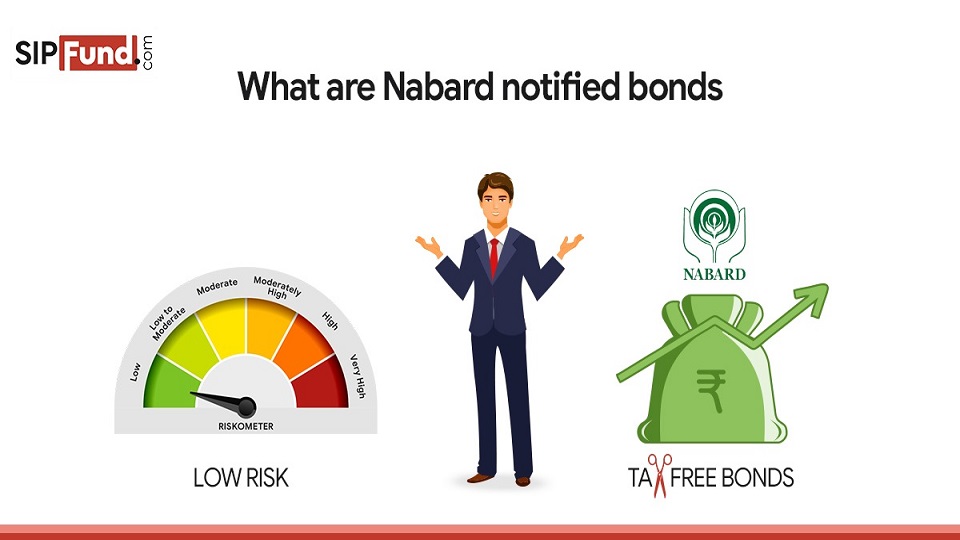
What are Nabard notified Bonds?
Amidst the volatility in stock markets, there are certain investment avenues to balance your portfolio’s risk. NABARD notified bonds is one of the investment tools which investors can choose to keep in their portfolio. In this article, we will read about NABARD notified bonds in detail:
NABARD notified bonds are made up of two words NABARD and bonds; let us read about them in brief first:
What is NABARD?
NABARD was established on the recommendations of B. Sivaraman Committee (Committee to Review the Arrangements For Institutional Credit for Agriculture and Rural Development (CRAFICARD)) on 12 July 1982 to implement the National Bank for Agriculture and Rural Development Act 1981.
Agricultural Credit Department (ACD) and Rural Planning and Credit Cell (RPCC) of Reserve Bank of India, and Agricultural Refinance and Development Corporation (ARDC) were merged to form NABARD.
NABARD’s major functions include the following:
1.It works as specialized regulatory for rural and agricultural development;
2.Supervise Regional Rural Banks (RRBs), State cooperative banks, Central cooperative banks;
3.Provide liquidity support to RRBs
4.Provides long term and short finance for agriculture and rural development.
What are bonds?
Bonds are used by large companies, Government, Government owned entities, municipal corporations to raise money from prospective investors in return of a fixed coupon rate. Investors give loans to these companies for a certain period of time and they get regular interest payments till the maturity of bonds. When bonds get matures, investors get their money back.
Having read about NABARD and bonds, let us now read about NABARD notified bonds:
What are NABARD notified bonds?
NABARD uses various types of resources to mobilize the funds. There are four types of bonds which have been issued to retail investors’ viz. Capital Gains Bonds, NABARD Rural Bonds, Bhavishya Nirman Bonds and Tax-Free Bonds by Finance Department of NABARD. In this article, we will focus on Tax-Free Bonds.
In March 2016, NABARD had come up with the concept of Tax-free bonds by issuing the bonds worth ₹ 5,000 crores. These were issued for the tenure of 10, 15, and 20 years. These bonds were awarded the rating of ‘CRISIL AAA/Stable’ and IND AAA/stable by the Credit Rating Information Services of India Limited (CRISIL) and by India Ratings respectively. These ratings are the highest ratings which means these bonds are safe and have a very minimal credit risk.
What are the features of NABARD notified bonds?
1.Coupon Rate -
There are two categories of coupon rates:1.Case a) -
where investment is less than 10 lakhs| Duration | Coupon rates (%)* |
|---|---|
| 15- years duration | 7.64 |
| 10- years duration | 7.29 |
1.Case b) -
where investment is above than 10 lakhs| Duration | Coupon rates (%)* |
|---|---|
| 15- years duration | 7.04 |
| 10- years duration | 7.35 |
*at the time of issue
2. Investment- These bonds were issued at a face value of ₹ 1,000. The minimum investment requirement was ₹ 5,000 and in multiples thereafter
3. Non-Resident Indians are not allowed to invest in tax free bonds of NABARD.
2.Tax benefits – NABARD notified bonds are free of taxes as there are no taxes on interest income. Investors get interest payments on an annual basis. r
What are the advantages of investing in NABARD notified bonds?
Investing in NABARD notified bonds can be beneficial to investors because of the following reasons:
Safest investment- Since these bonds are highly rated as AAA/AA, these are the safest investment tools because these are backed by NABARD which is a wholly owned organization of government of India.
Regular fixed income- These bonds provide interest income on a regular basis. Having some proportion of these bonds in your portfolio will hedge you against the volatility of the markets.
Capital appreciation- As the interest rates go south, the returns for investors go north since there is negative correlation between bonds coupon rates and returns to investors. Additionally, all the income is real income to investors since there are no tax deductions.
Exposure to secondary markets- The NABARD tax-free bonds are proposed to be listed on the Bombay Stock Exchange. This will provide bond holders the option to participate in secondary markets. There is also a provision that bond holders can trade in physical format also as having a DEMAT account is not compulsory.
What are the disadvantages of NABARD notified bonds?
There are other better options available in the market to appreciate your capital. Equity mutual funds giving returns 12% - 15% if one has risk tolerance is much better an investment option. NABARD notified bonds may be suitable for people who fall in high income tax bracket of 30%. These bonds will help wealthy people to generate systematic income over the longer period. On the other hand, people who are attracting income tax rates of 10% - 20% should not opt NABARD notified bonds since it is not the best investment option. Investment in equity mutual funds may be more suited to these investors.
Conclusion
NABARD tax-free bonds as the name suggests are free of taxes but opting these funds solely based on tax-free income is a suboptimal decision. Investors who are highly risk averse can opt these bonds as these provide stable income over a period. However, investors who have risk tolerance and longer-term financial goals which require a bigger wealth corpus should opt equity mutual funds. Investors should compare the trade-off between the high returns of mutual funds and the post-tax benefits of tax-free bond before investing in tax free bonds.
#NABARD #NotifiedBonds #RuralDevelopment #AgriculturalFinance #GovernmentBonds #SocialInvesting #FinancialInclusion #RuralEconomy #InvestmentOpportunity #NABARDBonds
